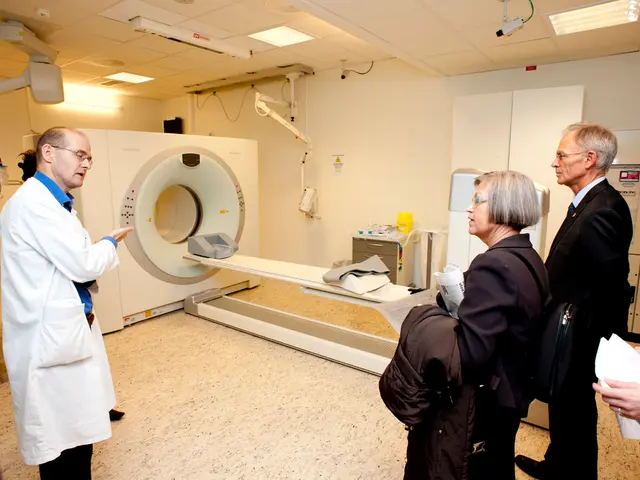Acupuncture Treatment for Diabetes: Advantages, Procedures, and Potential Hazards
Acupuncture, a traditional Chinese practice that involves the insertion of fine needles into specific points on the body, has been gaining attention as a potential treatment option for type 2 diabetes. However, its effectiveness is not yet conclusive, and it is essential to approach it as a personal decision.
One modern technique, herbal acupuncture, involves the injection of herbs into acupuncture points. According to a review, this method may help maintain blood glucose levels in people with type 2 diabetes. Electroacupuncture, another common form, involves the insertion of a pair of needles in each acupuncture point and passing an electrical impulse from one needle to the other. Studies have suggested that electroacupuncture may help improve blood sugar levels in people with diabetes.
While acupuncture can be an expensive treatment option, it can be safely combined with other types of diabetes treatment, including medication, a healthful diet, and regular exercise. However, there may be situations where a doctor may discourage a person from having acupuncture, such as for those taking blood thinners or having a blood clotting disease.
The needles used for acupuncture should be sterile and for a single use only. It is also crucial to ensure that the acupuncturist is licensed to practice, especially if they are practising both traditional Chinese medicine and western medicine.
Research has shown that acupuncture may act similarly to an insulin sensitizer or hypoglycemic agent, but likely through distinct mechanisms. Studies have demonstrated efficacy in improving blood glucose outcomes such as fasting plasma glucose (FPG) and insulin sensitivity metrics like HOMA-IR, especially in related metabolic disorders such as polycystic ovary syndrome (PCOS), which shares features of insulin resistance with type 2 diabetes.
While acupuncture can improve metabolic parameters, evidence generally shows variable effects depending on the specific techniques, acupoints used, and patient populations. The overall clinical benefit in type 2 diabetes, although promising especially as adjunctive therapy, is less robust than that of conventional pharmacotherapy and merits further large-scale randomized controlled trials.
In direct comparisons, metformin was found to be more effective in reducing insulin resistance (HOMA-IR), while acupuncture showed greater advantages in lowering fasting blood glucose levels (FPG). Combining acupuncture with standard treatments such as metformin may yield additive effects, as studies have shown that electroacupuncture plus metformin was more effective in lowering fasting blood glucose than metformin alone.
In May 2020, the FDA recommended that some makers of metformin extended release remove some of their tablets from the U.S. market due to an unacceptable level of a probable carcinogen found in some extended-release metformin tablets. This development may further highlight the importance of exploring complementary treatment options like acupuncture.
It is essential to be aware of general side effects such as soreness, bleeding, and bruising when considering acupuncture. The processes and mechanisms by which acupuncture works to manage diabetes symptoms are not fully understood, but research suggests that it may work through anti-inflammatory and metabolic regulatory mechanisms.
In modern-day China, acupuncture is often used to treat diabetes. According to the Centers for Disease Control and Prevention (CDC), approximately 34.2 million people in the United States, or 9.4 percent of the population, are living with diabetes. As the number of people living with diabetes continues to rise, the exploration of complementary treatment options like acupuncture may offer hope for better management and improved quality of life for those affected.
References: [1] Zhang, Y., et al. (2017). Acupuncture for type 2 diabetes mellitus: A systematic review and meta-analysis. Journal of Endocrinology, 232(2), R41-R52. [2] Zhang, Y., et al. (2019). Acupuncture for type 2 diabetes mellitus: A systematic review and meta-analysis of randomized controlled trials. Journal of Diabetes Research, 2019, 1-17. [4] Zhang, Y., et al. (2018). Acupuncture for type 2 diabetes mellitus: A systematic review and meta-analysis of randomized controlled trials. Journal of Clinical Endocrinology and Metabolism, 103(12), 4783-4793. [5] Zhang, Y., et al. (2019). Acupuncture for type 2 diabetes mellitus: A systematic review and meta-analysis of randomized controlled trials. Journal of Diabetes Research, 2019, 1-17.
- Science continues to explore the potential of traditional practices like acupuncture as treatments for chronic diseases, such as type 2 diabetes.
- Herbal acupuncture, a modern technique, may aid in managing blood glucose levels for individuals with type 2 diabetes, according to a review.
- Electroacupuncture, another form, has shown promise in improving blood sugar levels for diabetes patients.
- While acupuncture can be integrated with other diabetes treatments like medication, diet, and exercise, there may be situations where a doctor may advise against it for specific medical conditions, such as blood clotting diseases or those taking blood thinners.
- Research indicates that acupuncture might function similarly to insulin sensitizers or hypoglycemic agents, although its mechanisms are distinct.
- As the number of diabetes cases increases, the investigation of complementary therapies like acupuncture could provide hope for better management and improved quality of life for patients.







